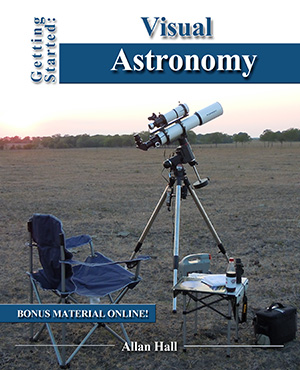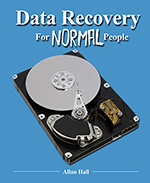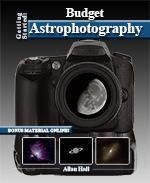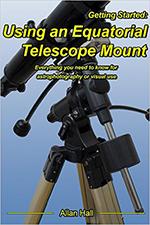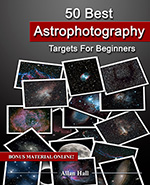Now available! Getting Started: Visual Astronomy
If you have ever wanted to view the wondrous objects of our solar system and beyond, here is the how-to manual to get you well on your way to enjoying visual astronomy. From purchasing your first telescope, through setting it up and finding objects, to viewing your first galaxy, this book contains everything you need. Learn how to read star maps and navigate the celestial sphere and much more. The book contains plenty of pictures, diagrams and charts to make visual astronomy easy. Written specifically for the novice at visual astronomy and assuming the reader has no prior knowledge. It makes sure that all topics are explained thoroughly from the ground up. Use this book to embark on a fantastic new hobby and learn about the universe at the same time!
Get your copy of Getting Started: Visual Astronomy today!
Paperback / Kindle
BUY NOW!
Here is the description from Amazon for visual astronomy:
Getting Started:Visual Astronomy focuses on beginner aspects of visual astronomy. This beginner’s guide covers all aspects of getting started with astronomy. From learning about the universe to understanding what to observe, how, and when. This comprehensive guide will become a go-to tool for novice and amateur astronomers.
Getting Started: Visual Astronomy is strategically divided into sections in order to help readers learn at a manageable pace. The first section, How We View Our Universe, details basic astronomical functions. Readers will learn about how the Earth rotates and thus our day and night sky seems to “change.” Also discussed is the movement of other celestial bodies, including the sun, moon, and planets, as well as celestial objects such as asteroids and meteors. Readers will learn about light pollution and its effects on astronomical observations. With this knowledge, readers can begin to plan when and where to view the sky, based on celestial and Earthly movements and light pollution.
The second section of the book, Equipment, is relatively self-explanatory. Various types of equipment are discussed, including binoculars, telescopes, and mounts. A breadth of information is provided on each piece of equipment. Readers will learn what can be viewed via binoculars or telescopes and the mechanisms that allow them to function. Once you learn about basic equipment, you will learn how to set it up. Discover how to find alignment, read various star maps, use supplementary computer software, and protect your gear from the elements.
Now that you’ve learned the basics about the universe and equipment used to view celestial bodies, it’s time for action. Section three, Observing, teaches readers how to put their knowledge to use and how to be an astronomer. Visual astronomy is a popular and special hobby, so there are different organizations, clubs, and even rules of etiquette about which to learn. However, this chapter begins with a brief history of astronomers ancient and more recent, from Aristotle to Carl Sagan. This section will also guide you while you pick an observing location. Using information from How We View Our Universe, you will know to pick a spot free of excessive light pollution. Learn about what to observe – from the sun to Pluto, you will have a reference guide full of information about best times, locations, and methods used to view different celestial bodies.
In addition to the three main chapters, there is a wealth of extra information. Included are multiple observational charts, which show the best and brightest astronomical events until 2025. You’ll know when to view solar and lunar eclipses, meteor showers, conjunctions, transits, and more. This makes it easy for you to plan observations and even star parties in advance. Also included is a glossary of terms, supplementary informational resources, and a guide to basic astronomical math.
Getting Started: Visual Astronomy is an excellent guide for beginners and amateurs who want to learn more about the night sky. Both an informational reference guide, science book, and history lesson, Getting Started: Visual Astronomy offers a comprehensive overview of all basic aspects of astronomy.
Listen to what readers are saying about Visual Astronomy:
“…this one is the book I would recommend to readers who wanted to purchase only one [astronomy] book.” – Jimmy Curtis via Amazon.com
“This book will help you get started in Astronomy and answers every question you have plus plenty more you didn’t know you had.” – K. Allen via Amazon.com
Files related to the book can be downloaded below:
| |
Read the table of contents |
| |
Read the introduction |
| |
General observing form |
| |
Meteor shower observing form |
| |
All star charts from the book in higher resolution |
Paperback / Kindle
BUY NOW!
I hope Getting Started: Visual Astronomy helps you enjoy your view of the heavens!
Share this post!





